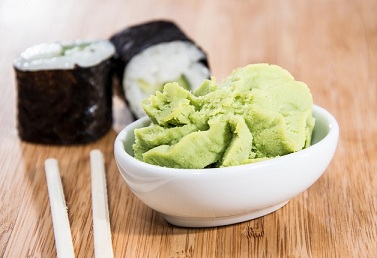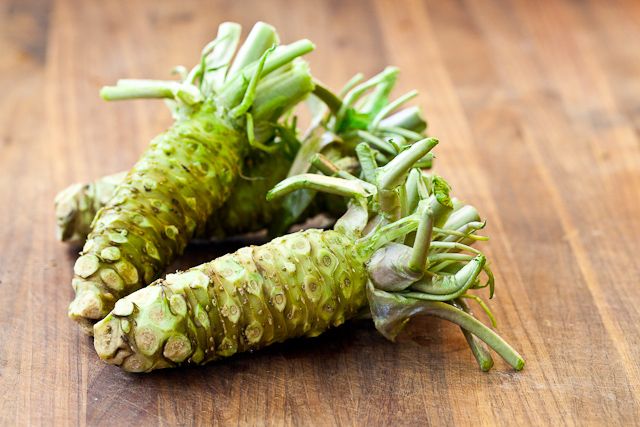COVID-19 Herbs: Japanese Wasabi Contains Certain Phytochemicals That Could Help With COVID-19! Further Studies Warranted
Source: COVID-19 Herbs Nov 01, 2020 5 years, 2 months, 13 hours, 44 minutes ago
COVID-19 Herbs: A new research is currently under way by Thailand Medical News to explore certain phytochemicals present in Wasabi that might have potential antiviral activity against the SARS-CoV-2 coronavirus and could maybe treat COVID-19 possibly in combination with other herbs and phytochemicals.

Wasabi a pungent condiment for sushi and other foods typically made by grinding into paste the rhizomes from the Wasabia japonica plant frequently referred to as the Japanese horseradish. It is a plant of the family Brassicaceae, which also includes horseradish and mustard in other genera. It is similar in taste to hot mustard or horseradish rather than chili peppers in that it stimulates the nose more than the tongue. Most wasabi found in most Japanese restaurants in Thailand, Unites States, United Kingdom, Canada, Australia etc are simply horseradish and food coloring!
The wasabia japonica plant grows naturally along stream beds in mountain river valleys in Japan. The two main strains rich in phytochemicals are the E. japonicum 'Daruma' and 'Mazuma', but there are many others. Due to policy issues that limit the Japanese wasabi plant's mass cultivation and thus increase its price and decreased availability outside Japan, the western horseradish plant is generally used in place of the Japanese horseradish.
 The wasabia japonica rhizome
The wasabia japonica rhizome
Fresh Wasabi contains protein, fiber, vitamins B6 and C, and the minerals calcium, magnesium, potassium and manganese. Wasabi is similar to many plants in the mustard family in that it contains a group of compounds called glucosinolates. These components are enzymatically converted to the bioactive isothiocyanates (ITCs).
The phytochemical in wasabi that provides for its initial pungency is the volatile compound allyl isothiocyanate, which is produced by hydrolysis of natural thioglucosides (conjugates of the sugar glucose, and sulfur-containing organic compounds); the hydrolysis reaction is catalyzed by myrosinase and occurs when the enzyme is released on cell rupture caused by maceration e.g., grating of the plant.
https://www.jstage.jst.go.jp/article/bbb1961/53/2/53_2_537/_article
https://pubs.acs.org/doi/abs/10.1021/bk-1996-0637.ch006
The same phytochemical is responsible for the pungency of horseradish and mustard.
The phytochemical allyl isothiocyanate can also be released when the wasabi plants have been damaged, because it i
s being used as a defense mechanism against plant fungus and also other pests.
https://www.tandfonline.com/doi/full/10.1080/17429145.2015.1039613
In humans, the sensory neural target of wasabi and mustard oil is the chemosensory receptor or gene TRPA1, also known as the ‘Wasabi Receptor’.
https://www.nature.com/articles/s41586-020-2480-9
https://www.ncbi.nlm.nih.gov/books/NBK5237/
The hot but unique flavor of wasabi is a result of complex chemical mixtures from the broken cells of the plant, including those resulting from the hydrolysis of thioglucosides from sinigrininto glucose and methylthioalkyl isothiocyanates such as 6-MITC 6-(Methylsulfinyl)hexyl isothiocyanate, 7-methylthioheptyl isothiocyanate and 8-methylthiooctyl isothiocyanate.
https://www.sciencedirect.com/science/article/abs/pii/S0304416501001611?via%3Dihub
https://cen.acs.org/articles/88/i12/Wasabi.html
https://www.tandfonline.com/doi/abs/10.1080/00021369.1989.10869320
https://pubs.acs.org/doi/abs/10.1021/bk-1996-0637.ch006?src=recsys
Wasabia differs from other crucifers in that it has higher concentrations of ITCs, especially long-chain ITCs. These long-chain ITCs (6-methylsulfinylhexyl isothiocyanate or 6-MITC, 7-methylsulfinylheptyl isothiocyanate and 8-methylsulfinyloctyl isothiocyanate) also give Wasabia its unique flavor, termed its “green note.” The enzyme responsible for converting the inert glucosinolates to ITC is myrosinase, a very labile molecule. If Wasabia is air-dried, its myrosinase breaks down; therefore, the ITCs that produce the characteristic heat, flavor and biomedical activity of Wasabia are not formed.
This is why traditionally only fresh rhizomes and leaves are used. Now researchers are finding that freeze-drying Wasabia will stabilize the activity of the myrosinase until exposed to water or digestive fluids.
The extraction process to obtain the various phytochemicals from wasabi is highly complicated and also tedious and time consuming.
Isothiocyanates are known to have antiviral properties.
https://bpspubs.onlinelibrary.wiley.com/doi/pdf/10.1111/j.1476-5381.1967.tb01971.x
The burning sensations of wasabi are not oil-based hence they are short-lived compared to the effects of capsaicin in chili peppers, and are washed away with more food or liquid. The sensation is felt primarily in the nasal passage and can be quite painful depending on the amount consumed. Inhaling or sniffing wasabi vapor has an effect like smelling salts, a property being exploited by researchers for various therapeutic uses.
Besides the 6-(methylsulfinyl)hexyl isothiocyanate, and other isothiocyanates, another important phytochemical identified in wasabi is monogalactosyl diacylglycerides,
Anti-Inflammatory Properties:
It has been found that Wasabi may be useful for controlling seasonal allergies and asthma. ITCs are effective agents for inflammation based on their rapid action and the low levels needed. 6-MITC can inhibit lipoxygenase, cyclooxygenase and cAMP phosphodiesterases that are involved in inflammation. Isothiocyanates of Wasabia and other crucifers are anti-inflammatory and anti-asthmatic.
https://pubmed.ncbi.nlm.nih.gov/23136589/
https://www.infona.pl/resource/bwmeta1.element.elsevier-bb1871ff-cf72-3bc1-bc56-6c96f8c03737
https://www.sciencedirect.com/science/article/abs/pii/0014299984900864
https://pubmed.ncbi.nlm.nih.gov/16139249/
https://pubmed.ncbi.nlm.nih.gov/28671636/
https://pubmed.ncbi.nlm.nih.gov/31216970/
A growing experience from natural health practitioners suggests that Wasabi can be an effective treatment for seasonal allergies as well as asthma and eczema and also numerous other inflammatory conditions.
Anti-Microbial Properties
The phytochemicals ITCs have an inhibitory effect on several strains of bacteria, yeast and mold. In fact, Wasabia japonica was first introduced into the raw fish diet of the Japanese for its anti-microbial properties. Isothiocyanate vapors inhibit the growth of several strains of bacteria, yeast and mold Several scientific studies have shown that 6-MITC from Wasabi extracts have potent anti-bacterial properties against Staphylococcus aureus and Escherichia coli. Isothiocyanates in Wasabi have demonstrated an inhibitory effect against Streptococcus mutans, the bacterium responsible for dental cavities. These results may lead to Wasabi extracts being used in a variety of products (i.e., toothpastes and mouthwashes) for cavity prevention. More recent research has proven Wasabi extracts inhibit mutant strains of the Staphylococcus. Another biomedically important bacterium that Wasabi and ITCs inhibit is Helicobacter pylori . This bacterium is known to be responsible for gastric ulcers and ensuing stomach cancers. Wasabi extracts kill the bacterium, even if it has entered cells lining the stomach.
https://www.tandfonline.com/doi/abs/10.1271/bbb.62.363
https://www.kpubs.org/article/articleMain.kpubs?articleANo=KSSHBC_1998_v31n6_835
https://pubmed.ncbi.nlm.nih.gov/15246236/
https://pubmed.ncbi.nlm.nih.gov/27708622/
https://pubmed.ncbi.nlm.nih.gov/30520603/
https://pubmed.ncbi.nlm.nih.gov/15246236/
https://pubmed.ncbi.nlm.nih.gov/20530903/
Anti-Platelet Properties
The inhibition of inappropriate platelet aggregation is important for protection against heart attacks and strokes. The 6-MITC of Wasabi has been found to inhibit platelet aggregation, a property useful in the elderly, where preventing excessive clotting is vital. Platelet aggregation is a precipitating factor in cardiovascular diseases. 6-MITC inhibits platelet aggregation by a number of different mechanisms, including the inhibition of lipoxygenase, cyclooxygenase, cAMP phosopodiesterases and cGMP phosphodiesterase.
https://www.tandfonline.com/doi/abs/10.1271/bbb.58.2131
https://pubmed.ncbi.nlm.nih.gov/11237193/
https://pubmed.ncbi.nlm.nih.gov/11706044/
Antiviral Properties
There has been past studies showing that phytochemicals from wasabi is effective against the Influenza viruses and other respiratory viruses.
https://onlinelibrary.wiley.com/doi/abs/10.1002/jsfa.3268
The isothiocyanates are also known to inhibit HIV genes and the Hepatitis C viruses.
https://europepmc.org/article/med/31706900
https://journals.plos.org/plosone/article?id=10.1371/journal.pone.0152236
Besides the antiviral properties of isothiocyanates, one of the other phytochemical found in wasabi is the monogalactosyl diacylglycerides which are also known to have antiviral properties against herpes
https://pubmed.ncbi.nlm.nih.gov/31310628/
https://www.mendeley.com/catalogue/17876193-9e12-344a-af97-0a044bbea2d3/
https://journals.plos.org/plosone/article?id=10.1371/journal.pone.0188609
The various other phytochemicals in the wasabi plant are known for a host of other health benefits including for treating diabetes, having anti-cancer properties and also neuro-protective properties.
However Thailand Medical News is focusing on the antiviral aspects of only the two main phytochemicals in wasabi ie the isothiocyanates and also the monogalactosyl diacylglycerides.
We are exploring the effects of these phytochemicals in vitro and vivo studies involving various strains of the SARS-CoV-2 coronavirus and also on the various cellular pathways and genes in the human immune system.
Preliminary computational molecular docking studies involving the SARS-CoV-2 genome which have yet to be published have also shown potential applications with some of these identified phytochemicals.
Thailand Medical News has been working with various researchers around the world on herbal and phytochemical studies and we are developing various blends of therapeutic teas to help treat the various aspects COVID-19 disease either as an adjuvant or by themselves.
https://www.thailandmedical.news/news/new-therapeutic-teas-
https://www.thailandmedical.news/articles/covid-19-herbs
To date we have already have a few blends that are being patented whose effectiveness have proven to be positive in observational studies in various countries and we are still refining our formulations with additional research. We are also developing blends for the various Post-COVID-19 long term health effects including fatigue, myocarditis, lung and kidney injury, cognitive deficits, gastroenterological issues, neurological issues and also strokes.
We strongly believe that herbs and phytochemicals are the answer to COVID-19 disease and unlike other herb based products, we are very much into detailed and intensive state of the art research with the backing of proper published data on the mechanisms of how every herb and its phytochemicals work on a cellular level to in vitro studies with proper standards including covering a wide range of the prevailing SARS-CoV-2 strains, similar vivo studies with animal models and also observational human clinical trial studies. We are shortly initiating a few randomized trials and are also into epigenetic studies involving these phytochemicals and human host genes that are affected by the viroporins of the SARS-CoV-2 coronavirus.
We are also appealing to generous donors who can help fund some of our research studies. Currently were still desperately short of US$96,000 out of the last batch of US$122,000 we need. (We had one kind Thai donor who has helped us with US$26,000) and we have already invested more than US$1.3 million of our own monies into this project. We have appealed many times on this website but despite having tons of readers, we have not really got any response. We do hope that some kind and generous donors out there would see our appeal for help and hopefully respond.(Venture capitalists, investors seekings returns or individuals seeking huge profits need not respond, as we are only in for humanitarian purposes and we do not deal with greedy individuals trying to make monies by exploiting others!)
For more on
COVID-19 Herbs, keep on logging to Thailand Medical News.

